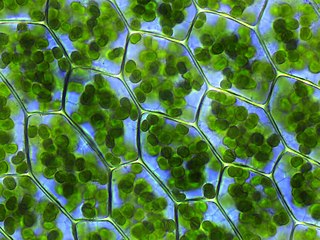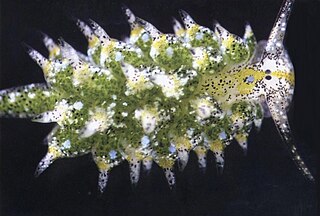
Photosynthesis is a biological process used by many cellular organisms to convert light energy into chemical energy, which is stored in organic compounds that can later be metabolized through cellular respiration to fuel the organism's activities. The term usually refers to oxygenic photosynthesis, where oxygen is produced as a byproduct and some of the chemical energy produced is stored in carbohydrate molecules such as sugars, starch, glycogen and cellulose, which are synthesized from endergonic reaction of carbon dioxide with water. Most plants, algae and cyanobacteria perform photosynthesis; such organisms are called photoautotrophs. Photosynthesis is largely responsible for producing and maintaining the oxygen content of the Earth's atmosphere, and supplies most of the biological energy necessary for complex life on Earth.

The plastid is a membrane-bound organelle found in the cells of plants, algae, and some other eukaryotic organisms. They are considered to be intracellular endosymbiotic cyanobacteria. Examples include chloroplasts, chromoplasts, and leucoplasts.

Sacoglossa, commonly known as the sacoglossans or the "solar-powered sea slugs", are a superorder of small sea slugs and sea snails, marine gastropod mollusks that belong to the clade Heterobranchia. Sacoglossans live by ingesting the cellular contents of algae, hence they are sometimes called "sap-sucking sea slugs".

Kleptoplasty or kleptoplastidy is a process in symbiotic relationships whereby plastids, notably chloroplasts from algae, are sequestered by the host. The word is derived from Kleptes (κλέπτης) which is Greek for thief. The alga is eaten normally and partially digested, leaving the plastid intact. The plastids are maintained within the host, temporarily continuing photosynthesis and benefiting the host.

The Archaeplastida are a major group of eukaryotes, comprising the photoautotrophic red algae (Rhodophyta), green algae, land plants, and the minor group glaucophytes. It also includes the non-photosynthetic lineage Rhodelphidia, a predatorial (eukaryotrophic) flagellate that is sister to the Rhodophyta, and probably the microscopic picozoans. The Archaeplastida have chloroplasts that are surrounded by two membranes, suggesting that they were acquired directly through a single endosymbiosis event by phagocytosis of a cyanobacterium. All other groups which have chloroplasts, besides the amoeboid genus Paulinella, have chloroplasts surrounded by three or four membranes, suggesting they were acquired secondarily from red or green algae. Unlike red and green algae, glaucophytes have never been involved in secondary endosymbiosis events.

Photoinhibition is light-induced reduction in the photosynthetic capacity of a plant, alga, or cyanobacterium. Photosystem II (PSII) is more sensitive to light than the rest of the photosynthetic machinery, and most researchers define the term as light-induced damage to PSII. In living organisms, photoinhibited PSII centres are continuously repaired via degradation and synthesis of the D1 protein of the photosynthetic reaction center of PSII. Photoinhibition is also used in a wider sense, as dynamic photoinhibition, to describe all reactions that decrease the efficiency of photosynthesis when plants are exposed to light.

Elysia chlorotica is a small-to-medium-sized species of green sea slug, a marine opisthobranch gastropod mollusc. This sea slug superficially resembles a nudibranch, yet it does not belong to that clade. Instead it is a member of the clade Sacoglossa, the sap-sucking sea slugs. Some members of this group use chloroplasts from the algae they eat for photosynthesis, a phenomenon known as kleptoplasty. Elysia chlorotica is one species of such "solar-powered sea slugs". It lives in a subcellular endosymbiotic relationship with chloroplasts of the marine heterokont alga Vaucheria litorea.

Elysia viridis, the sap-sucking slug, is a small-to-medium-sized species of green sea slug, a marine opisthobranch gastropod mollusc in the family Plakobranchidae.

Elysia is a genus of sea slugs, marine gastropod molluscs in the family Plakobranchidae. These animals are colorful sea slugs, and they can superficially resemble nudibranchs, but are not very closely related to them. Instead they are sacoglossans, commonly known as sap-sucking slugs.

Elysia crispata, common name the lettuce sea slug or lettuce slug, is a large and colorful species of sea slug, a marine gastropod mollusk.

Photosynthetic reaction centre proteins are main protein components of photosynthetic reaction centres (RCs) of bacteria and plants. They are transmembrane proteins embedded in the chloroplast thylakoid or bacterial cell membrane.

Paulinella is a genus of at least eleven species including both freshwater and marine amoeboids. Like many members of euglyphids it is covered by rows of siliceous scales, and use filose pseudopods to crawl over the substrate of the benthic zone.

Ochrophytes are the photosynthetic stramenopiles, a group of eukaryotes characterized by the presence of two unequal flagella, one of which has tripartite hairs called mastigonemes. In particular, ochrophytes are characterized by their plastids enclosed by four membranes, with thylakoids organized in piles of three, and the presence of chlorophylls a, c, and additional pigments such as β-carotene and xanthophylls. Ochrophytes are one of the most diverse lineages of eukaryotes, containing ecologically important algae such as brown algae and diatoms. They are classified either as phylum Ochrophyta or subphylum Ochrophytina within phylum Gyrista. Their plastid is of red algal origin.

Elysia timida is a species of sacoglossan sea slug, a marine opisthobranch gastropod mollusk. Found in the Mediterranean and nearby parts of the Atlantic, it is herbivorous, feeding on various algae in shallow water.

Elysia pusilla is a species of small sea slug, a marine gastropod mollusk in the family Plakobranchidae. It is a sacoglossan.

Plakobranchus ocellatus is a species of sea slug, a sacoglossan, a marine opisthobranch gastropod mollusk in the family Plakobranchidae. It is found in shallow water in the Indo-Pacific region.
The evolution of photosynthesis refers to the origin and subsequent evolution of photosynthesis, the process by which light energy is used to assemble sugars from carbon dioxide and a hydrogen and electron source such as water. The process of photosynthesis was discovered by Jan Ingenhousz, a Dutch-born British physician and scientist, first publishing about it in 1779.

Costasiella ocellifera is a small (5–13 mm) species of sea slug, a shell-less marine gastropod mollusk in the family Costasiellidae. Costasiella ocellifera, and other members of the Costasiellidae family are often mistakenly classified as nudibranchs because they superficially resemble other species of that group, but they are actually a part of the Sacoglossa superorder of sea slugs, also known as the “sap-sucking sea slugs,” "crawling leaves" or the "solar-powered sea slugs." C. ocellifera was discovered by Simroth in 1895, and was initially classified as Doto ocellifera. The Brazilian species, Costasiella liliana, is a synonym of C. ocellifera.Costasiella ocellifera shows long-term retention of functional kleptoplasty.
Rhodelphis is a single-celled archaeplastid that lives in aquatic environments and is the sister group to red algae and possibly Picozoa. While red algae have no flagellated stages and are generally photoautotrophic, Rhodelphis is a flagellated predator containing a non-photosynthetic plastid. This group is important to the understanding of plastid evolution because they provide insight into the morphology and biochemistry of early archaeplastids. Rhodelphis contains a remnant plastid that is not capable of photosynthesis, but may play a role in biochemical pathways in the cell like heme synthesis and iron-sulfur clustering. The plastid does not have a genome, but genes are targeted to it from the nucleus. Rhodelphis is ovoid with a tapered anterior end bearing two perpendicularly-oriented flagella.

Photoautotrophs are organisms that use light energy and inorganic carbon to produce organic materials. Eukaryotic photoautotrophs absorb energy through the chlorophyll molecules in their chloroplasts while prokaryotic photoautotrophs use chlorophylls and bacteriochlorophylls present in free-floating thylakoids in their cytoplasm. All known photoautotrophs perform photosynthesis. Examples include plants, algae, and cyanobacteria.


















